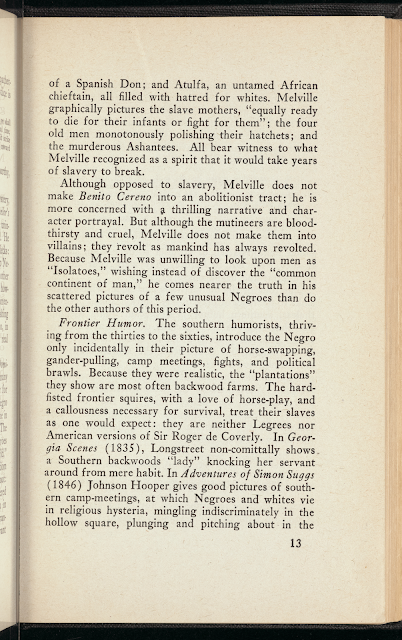Benito Cereno (1855) is a masterpiece of mystery, suspense and terror. Captain Delano of the Bachelor's Delight, discovering a vessel in distress along the uninhabited coast of Chile, boards her to render aid. He is interested in the many Negroes he finds on the decks: “ like most men of a good blithe heart he took to Negroes not philanthropically, but genially, just as other men to Newfoundland dogs." He is mystified, however, when the gamesome Negroes flare up in momentary rage, and especially by their continual clashing their hatchets together. Only when Don Benito, in desperation, escapes to Delano's ship, does the real truth dawn.
There had been a revolt on board the San Dominick; the Negro sailors and the slaves had killed many of the whites, and had kept the others alive only for their skill as navigators in order to reach a Negro country. The mutineers and revolters are overcome in a bloody battle, carried to Lima, and executed. The contrast between the reputed gentleness of Negroes "that makes them the best body-servants in the world," and the fierceness with which they fight for freedom is forcibly driven home. Certain Negroes stand out: Babo who, resembling a "begging friar," engineered the revolt with great skill and is almost fiendish in his manner of breaking down Cereno's morale; Francesco, the mulatto barber; Don José, personal servant of a Spanish Don; and Atulfa [Atufal], an untamed African chieftain, all filled with hatred for whites. Melville graphically pictures the slave mothers, "equally ready to die for their infants or fight for them”; the four old men monotonously polishing their hatchets; and the murderous Ashantees. All bear witness to what Melville recognized as a spirit that it would take years of slavery to break.
Although opposed to slavery, Melville does not make Benito Cereno into an abolitionist tract; he is more concerned with a thrilling narrative and character portrayal. But although the mutineers are bloodthirsty and cruel, Melville does not make them into villains; they revolt as mankind has always revolted. Because Melville was unwilling to look upon men as “Isolatoes," wishing instead of discover the "common continent of man,” he comes nearer the truth in his scattered pictures of a few unusual Negroes than do the other authors of this period.
-- Sterling Allen Brown, The Negro in American Fiction (Washington, DC, 1937) pages 12-13.
"Brown's analysis of Benito Cereno is the best I have seen...."--Joseph Schiffman, Critical Problems in Melville's Benito Cereno, Modern Language Quarterly volume 11 issue 3 (September 1950) pages 317-324 at page 323, footnote 23.
Twelve years later Schiffman "changed his mind" about alleged racism in Melville's tale, as pointed out in the arresting "Topics and Questions" section of
A Benito Cereno Handbook, edited by Seymour Lee Gross (Belmont, California: Wadsworth, 1965) page 187. The 1965
Handbook reprints editorial commentary on
Benito Cereno in
Three Shorter Novels of Herman Melville (New York: Harper & Row, 1962) where Schiffman concludes that by "highlighting the savagery of the rebellion, Melville sullied his tale with racism." Also excerpted in the handy
Benito Cereno Handbook:
the 1956 article by Warren D'Azevedo,
“Revolt on the San Dominick” in Phylon Volume 17, Number 2 (1956) pages 129–140. Conveniently accessible via JSTOR, www.jstor.org/stable/272586.
There D'Azevedo treated Benito Cereno as "a profound analysis of the effects of slavery and oppression upon the relationships of men," and Sterling Allen Brown got the last word.
Another testament to mid 1960's fascination with "Benito Cereno" is John Paul Runden,
Melville's Benito Cereno: A Text for Guided Research (Heath, 1965). Runden skips D'Azevedo, but Runden and Gross both excerpt the influential two-part article by Sidney Kaplan in
The Journal of Negro History Volume 41 (October 1956) and Volume 42 (January 1957)
challenging the accepted "image of
Melville as subtle abolitionist in
Benito Cereno" (1957, quoted in Runden at page 167). Kaplan labels this disputed reading "the Brown-Schiffman-Glicksberg thesis" crediting (and rejecting) Charles I. Glicksberg on
Melville and the Negro Problem along with Brown and Schiffman.
Ably defending the besieged thesis of Brown et al. in 1961, Allen Guttmann in "The Enduring Innocence of Captain Amasa Delano," Boston University Studies in English Volume 5 (Spring 1961) pages 35-45 re-emphasized the limited perspective of Melville's Delano as "a character whose failure to understand is underlined on almost every page."
"is the very opposite of racist, that it is rather a
subtle indictment of slavery, and a grim warning of the perils in store for those who,
like Amasa Delano, ignore or dismiss its dangers."
Brown's
The Negro in American Fiction is on Google Books
https://books.google.com/books/about/The_Negro_in_American_Fiction.html?id=rXhBAAAAIAAJ
https://hdl.handle.net/2027/uc1.b4376173?urlappend=%3Bseq=20
Digitized images of this item (in the public domain under U.S. laws) are accessible via
NYPL Digital Collections. Citation:
Schomburg Center for Research in Black Culture, Jean Blackwell Hutson Research and Reference Division, The New York Public Library. "The Negro in American Fiction" The New York Public Library Digital Collections. 1937. http://digitalcollections.nypl.org/items/f0a11c90-080b-0135-79ca-0d6aeeb931ad
Related posts:
Wed, Sep 15, 1926 – 1 · The Yonkers Herald (Yonkers, New York) · Newspapers.com








